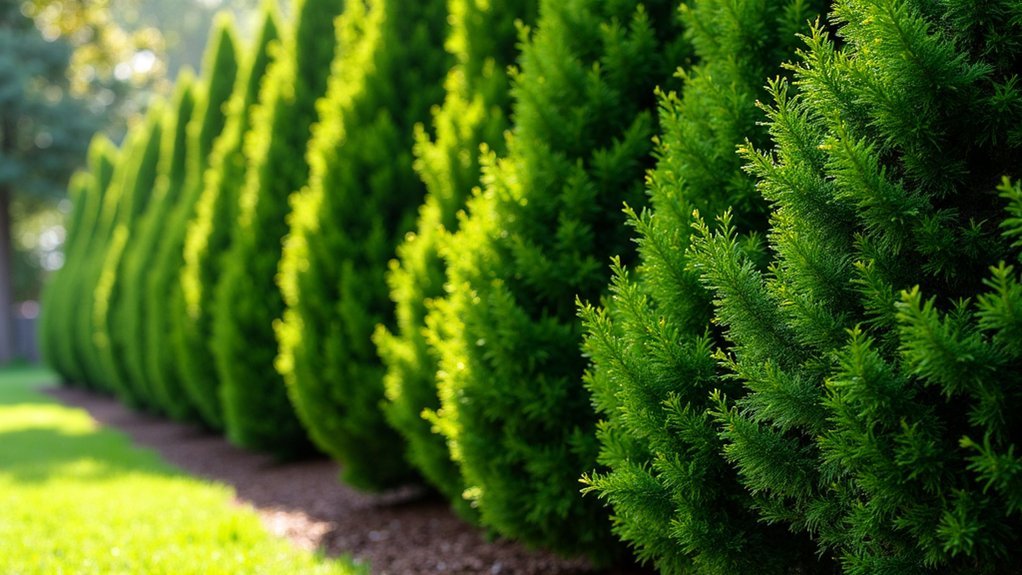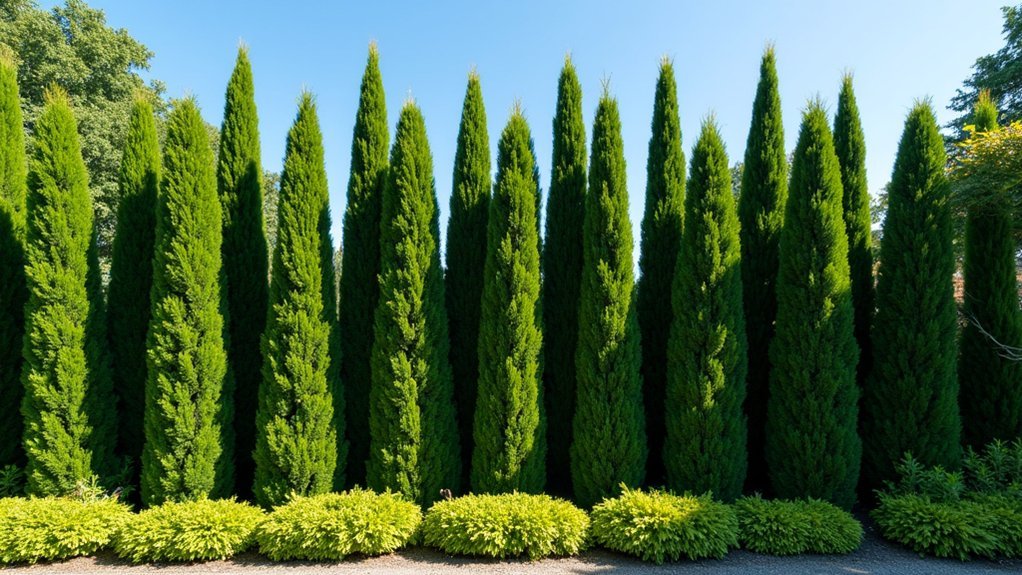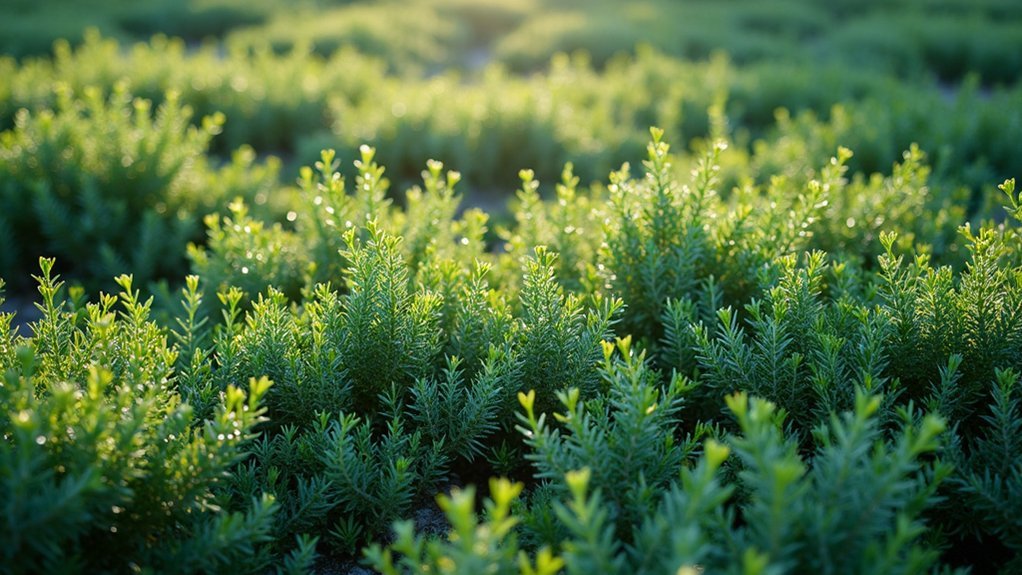For natural sound barriers, plant fast-growing Leyland Cypress, Nellie Stevens Holly, or Willow Hybrids (growing 6-10 feet annually). Emerald Green Arborvitae works well in tight spaces, while American Holly, Italian Cypress, Cherry Laurel, Boxwood, and Juniper offer dense noise-absorbing foliage. Combine these plants with soil berms for maximum effect—properly designed vegetation screens can reduce noise by up to 10 decibels. Discover how strategic placement can transform your outdoor sanctuary.
Leyland Cypress: The Fast-Growing Living Sound Wall

When seeking a natural solution for noise pollution, Leyland Cypress stands out as an exceptional choice for creating living sound barriers.
These evergreens grow an impressive 2-3 feet annually, quickly establishing a dense wall that can reach 40-60 feet at maturity.
With rapid growth of 2-3 feet yearly, these towering evergreens create dense living barriers reaching up to 60 feet tall.
You’ll appreciate the year-round noise protection from their soft, emerald-green foliage that effectively absorbs sound. Unlike deciduous alternatives, Leyland Cypress maintains its sound-blocking capabilities throughout all seasons.
For maximum effectiveness, plant these trees closely together in full sun and well-draining soil. For enhanced density and noise reduction, consider planting Leyland Cypress in staggered rows similar to Arborvitae.
They’re not just functional but economical too, offering both privacy and noise reduction in one attractive package.
Consider integrating them with other shrubs in a layered approach for enhanced sound-blocking performance.
Nellie Stevens Holly: Year-Round Noise Reduction in Record Time
You’ll love how Nellie Stevens holly provides a sound-blocking solution that grows up to 3 feet annually, quickly establishing a noise barrier around your property.
Its dense, glossy evergreen foliage creates an effective year-round sound buffer that maintains its screening capability through all seasons.
For maximum noise reduction effectiveness, position these hollies along property lines facing traffic sources or between outdoor living spaces and street noise, planting them 5-6 feet apart for ideal coverage. These hardy trees have proven to be deer-resistant, making them an excellent choice for properties in areas with wildlife that might otherwise damage your sound barrier.
Rapid Growth Benefits
Nearly every homeowner seeking noise reduction wants results quickly, and Nellie Stevens Holly delivers impressively.
With growth rates of 2-3 feet annually, you’ll see your sound barrier take shape in record time compared to slower-growing alternatives.
You can maximize this rapid growth by spacing plants 5-6 feet apart, creating a dense, impenetrable screen that absorbs neighborhood noise.
The holly’s self-pollinating nature means you’ll enjoy decorative red berries without needing multiple plant varieties, adding visual interest to your sound barrier.
This versatile plant thrives in various conditions—sun or shade, pollution or salt exposure—making it ideal for properties near busy streets.
Its low maintenance requirements mean you’ll spend less time tending to your sound barrier and more time enjoying the peaceful environment it creates. The naturally pyramidal shape of Nellie Stevens Holly provides excellent vertical coverage for sound blocking while maintaining an attractive appearance in your landscape.
Dense Evergreen Barrier
Unlike deciduous plants that shed their leaves seasonally, Nellie Stevens Holly delivers robust noise reduction every day of the year.
This evergreen powerhouse creates an effective sound barrier with its dense foliage while enhancing your landscape’s visual appeal. Strategically placing these hollies near noise sources maximizes their sound-dampening effectiveness.
You’ll appreciate these standout benefits:
- Impressive dimensions – Grows up to 20 feet tall and 18 feet wide, creating a substantial natural sound wall
- Year-round performance – Maintains thick, sound-absorbing foliage regardless of season
- Climate adaptability – Thrives in USDA zones 6-9 with minimal maintenance
- Multi-functional value – Serves as both privacy screen and noise buffer while producing ornamental red berries in winter
For consistent sound reduction with aesthetic appeal, you won’t find a more reliable option than this hardy evergreen.
Strategic Planting Locations
Strategic placement of your Nellie Stevens Holly transforms it from merely attractive vegetation into a formidable sound barrier that delivers maximum noise reduction.
Position trees 5-6 feet apart along northern property lines to block prevailing winds carrying noise. For maximum effectiveness, stagger rows to create multiple sound diffusion points rather than a single line.
Take advantage of your landscape’s natural contours by planting along elevated areas where sound waves can be intercepted and deflected.
Place hollies adjacent to hardscapes like patios and driveways to minimize echo, and surround pool areas to absorb water activity noise. With its glossy, dark leaves and dense pyramidal growth, Nellie Stevens Holly creates an effective visual and acoustic screen year-round.
Road-facing borders benefit most from these 15-25 foot tall barriers, especially when underplanted with boxwoods to fill low-level sound gaps.
Mulch bases to reduce ground-level sound reflection.
Emerald Green Arborvitae: Compact Sound Barriers for Urban Spaces
When space comes at a premium in urban environments, Emerald Green Arborvitae stands out as an exceptional choice for creating effective sound barriers. This evergreen’s dense, soft foliage absorbs sound waves while requiring minimal maintenance—perfect for busy city dwellers seeking tranquility.
You’ll appreciate these urban-friendly features:
- Space efficiency – Can be planted closer together than other species, creating impenetrable hedges in limited areas.
- Year-round performance – Maintains its noise-dampening foliage throughout all seasons.
- Adaptability – Thrives in partial shade and various soil conditions common in urban settings.
- Enhanced effectiveness – Planting in staggered, multiple rows considerably boosts noise reduction beyond single-digit percentages.
For maximum sound blocking, consider combining these compact pyramidal trees with other plant species in a strategic, layered approach. Regular pruning once yearly helps maintain the desired shape and size while preserving the dense growth pattern that makes these trees so effective at noise reduction.
Willow Hybrid: Creating Tall Sound Barriers Within a Single Season

If you’re seeking immediate sound reduction without waiting years for traditional screening plants to mature, Willow Hybrid trees offer an unmatched solution.
These remarkable trees grow 6-10 feet annually, reaching up to 15 feet in a single established season.
For maximum effectiveness, plant them densely to create a living barrier that absorbs sound waves while providing privacy.
You’ll benefit from additional advantages including wind protection, soil stabilization, and erosion control.
Their extensive root systems contribute to climate change mitigation through carbon sequestration.
With a 25-year lifespan and minimal maintenance requirements due to natural pest resistance, Willow Hybrids represent a sustainable alternative to concrete barriers.
They thrive in various climates, though they’ll perform best with adequate rainfall and occasional fertilization to promote vigorous branching and foliage.
A study in Quebec demonstrated these willows can endure harsh winter conditions with nearly 100% survival even at temperatures reaching -30°C (-22°F).
American Holly: Dense Foliage for Multi-Frequency Noise Absorption
While Willow Hybrids offer rapid growth and seasonal development, American Holly (Ilex opaca) stands out for its impressive density and year-round sound absorption capabilities. Its spiny evergreen foliage grows thickly from ground level upward, creating effective barriers that absorb sound waves across multiple frequencies.
American Holly creates an unmatched sound barrier with dense, evergreen foliage that blocks noise year-round where other trees fail.
When designing your sound-blocking screen with American Holly, consider:
- Plant trees 5-6 feet apart to create a continuous barrier without gaps
- Allow space for mature growth up to 50 feet tall and 40 feet wide
- Position in full to partial sun for ideal dense foliage development
- Utilize in USDA Hardiness Zones 5-9 for best performance
You’ll appreciate American Holly’s pyramidal shape and glossy leaves that effectively diffuse noise while providing year-round protection, unlike deciduous alternatives that lose effectiveness in winter. For optimal growth and berry production, ensure your holly plants have acidic soil preferred with good drainage.
Italian Cypress: Narrow Profile Solutions for Limited Space Installations

Italian Cypress trees offer an elegant solution for homeowners with limited space who still need effective sound barriers.
These columnar evergreens grow up to 40 feet tall while maintaining their slender profile, making them perfect for tight areas where traditional barriers won’t fit.
You’ll appreciate their dense, year-round foliage that effectively blocks unwanted noise while adding Mediterranean charm to your landscape.
For maximum sound reduction, plant them closely together along property lines or near noise sources. Varieties like Blue Italian Cypress and Glauca offer attractive blue-gray foliage options.
For enhanced effectiveness, combine your cypress with other evergreens like holly to create layered, diverse foliage that absorbs different sound frequencies. While trees alone provide modest noise reduction, they significantly improve perceived quietness when combined with other sound management strategies.
You’ll enjoy both the practical benefits of noise reduction and the aesthetic improvement to your outdoor space.
Cherry Laurel: Glossy-Leaved Hedges That Block Urban Noise
Cherry Laurel’s dense foliage creates an exceptional sound barrier that can reduce urban noise pollution considerably more than many alternative hedges.
You’ll appreciate its versatility, as this glossy-leaved plant grows quickly in various conditions—from full sun to partial shade—while requiring minimal maintenance.
Its remarkable resistance to urban pollutants means your sound-blocking hedge will remain healthy and effective even in challenging city environments. According to recent agricultural engineering research, proper hedge establishment techniques can enhance noise reduction by creating optimal leaf density for sound wave absorption.
Dense Sound Absorption Properties
The science behind cherry laurel’s exceptional noise-blocking ability makes it a standout choice for urban gardens.
These glossy-leaved hedges provide impressive sound attenuation that increases with frequency, making them particularly effective against high-pitched urban noises.
Unlike deciduous alternatives, cherry laurel offers year-round protection with its evergreen foliage that both absorbs and deflects sound waves.
You’ll appreciate how this natural sound barrier works:
- Dense, year-round foliage creates consistent noise reduction
- Thick leaves absorb and deflect sound waves more effectively as frequency increases
- Extensive coverage blocks noise from roads, neighbors, and construction
- Multifunctional benefits include air pollution filtering while creating sound privacy
Cherry laurel’s exceptional performance in various soils and light conditions makes it ideal for any urban setting requiring sound protection.
The fast-growing nature of cherry laurel allows homeowners to establish an effective noise barrier quickly, reaching impressive heights of up to 10 feet when properly maintained.
Fast Versatile Growing Patterns
For homeowners seeking quick privacy solutions, cherry laurel offers remarkably fast growth patterns that guarantee your sound barrier develops in record time.
You’ll see 2-3 feet of growth annually until maturity, with even faster development when properly pruned after flowering.
Plant your cherry laurels 60-90cm apart for single rows, or create denser coverage with staggered double rows spaced 45-60cm apart.
They’ll thrive in zones 6-9 across various soil types, adapting to both full sun and partial shade conditions.
For ideal growth, plant in early spring or fall, and maintain regular pruning to stimulate lateral branching.
You’ll get the fastest establishment in well-drained soil enriched with organic matter, along with consistent watering during the initial growth phase.
These evergreen plants showcase bright green, glossy leaves that remain vibrant year-round, adding aesthetic appeal to your sound-blocking hedge.
Urban Pollution Resistance
Urban environments pose unique challenges for plant survival, and cherry laurel rises to meet them with exceptional resilience.
You’ll find these glossy-leaved hedges not only block noise effectively but also combat pollution in surprising ways.
Cherry laurels thrive in city settings because they:
- Filter harmful air pollutants, creating a healthier microclimate around your home
- Maintain their dense, evergreen foliage year-round, providing consistent pollution resistance
- Adapt to various soil types and conditions, including drought once established
- Tolerate both full sun and partial shade, making them versatile for different urban landscapes
This hardy hedge requires minimal maintenance while offering maximum benefits, making it an ideal choice for urban dwellers seeking both sound barriers and cleaner air. Growing up to 2 feet per year, cherry laurel quickly establishes an effective privacy screen.
Boxwood: Layered Sound Absorption for Complete Noise Control
Dense boxwood hedges offer a sophisticated approach to noise control through their unique layered sound absorption properties.
You’ll appreciate how boxwood’s compact growth habit creates multiple sound-absorbing layers, trapping noise waves as they attempt to pass through the foliage.
For maximum effectiveness, combine boxwood with other materials like plywood backings. The acoustic performance of such combinations parallels that of plywood paneling systems which can achieve absorption ranges from 0.2 at 125 Hz to 0.1 at 4 kHz.
This layered technique addresses different frequency ranges—the boxwood absorbs mid to high frequencies while structural elements handle lower ones.
The plant’s natural moisture content enhances its sound-absorbing coefficient, potentially reaching up to 0.40.
Boxwood requires minimal maintenance while providing continuous noise reduction.
Juniper: Spreading Ground Cover to Minimize Sound Reflection

While traditional barriers reflect sound waves, spreading juniper groundcover absorbs and diffuses noise, making it an excellent choice for minimizing sound reflection in your landscape.
Unlike hard surfaces that bounce noise back, juniper groundcover quietly captures and disperses sound waves, creating a more peaceful outdoor environment.
When combined with berms or other barriers, juniper can reduce noise by up to 15 decibels, providing year-round protection thanks to its evergreen nature.
For maximum sound-blocking effectiveness:
- Plant in well-drained soil and apply mulch to control weeds and retain moisture.
- Combine low-growing varieties like Creeping Juniper with taller vegetation for layered sound absorption.
- Space properly to create dense coverage while allowing plants to spread naturally.
- Integrate with other evergreens and landscape features for continuous noise protection beneath larger plants.
You’ll appreciate both the noise reduction and the attractive, low-maintenance ground cover juniper provides. Planting juniper perpendicular to noise coming from busy roads significantly enhances its sound-blocking capabilities.
Building Effective Berms: Elevating Your Plant Barriers for Enhanced Sound Blocking
To maximize your sound barrier’s effectiveness, you’ll need berms that rise several feet above the line of sight between noise sources and your property.
You can strategically layer soil in a sloped formation, creating a natural platform that elevates your sound-blocking plants and absorbs up to 15 dBA of noise.
Anchor your plants with deep-rooted varieties along the berm’s contours to prevent erosion while enhancing the barrier’s long-term stability and acoustic performance.
Height for Maximum Impact
When planning your sound-blocking plant barrier, height plays an essential role in effectiveness. To achieve maximum noise reduction of up to 15 dBA, your berm must effectively block the line of sight between the noise source and your property. Higher berms deliver better results, but require more land area.
For stability, follow this design guidance:
- Build berms at least 3 feet wide for every 1 foot in height
- Aim for a 3:1 slope configuration for ideal sound blocking
- Keep walls under half the total barrier height for best performance
- Plant vegetation on the berm to enhance both sound absorption and aesthetics
Remember that earthen berms are approximately 2 dBA less effective than sound walls at the same height, but often provide better visual appeal.
Strategic Soil Placement
Building upon the height principles, the strategic placement of soil forms the foundation of an effective sound-blocking berm. Position your earthen berms close to the noise source rather than your property line for maximum efficiency. Create substantial structures with heights of 3-6 feet and gentle slopes (3:1 or 4:1 ratio) to guarantee stability while effectively deflecting sound waves upward.
| Soil Characteristic | Benefit | Implementation |
|---|---|---|
| Dense, compacted soil | Greater sound absorption | Layer and compress during construction |
| Moisture retention | Enhanced sound blocking | Incorporate organic matter |
| Layered composition | Varied frequency absorption | Use different soil densities |
| Erosion resistance | Maintains berm integrity | Add stabilizing groundcover |
| Plant-supporting | Sustains sound-blocking vegetation | Mix topsoil with structural base |
Your berm’s soil composition directly impacts its sound-blocking effectiveness, with denser, moisture-retaining soil providing superior noise reduction compared to loose, dry earth.
Plant Anchoring Techniques
Creating effective sound barriers requires more than just planting—your plants need proper anchoring to maximize noise reduction capabilities while ensuring long-term stability.
Properly constructed earthen berms can reduce noise by an impressive 6-15 decibels when combined with strategic planting.
Here’s how to anchor your sound-blocking plants effectively:
- Construct berms with gentle slopes – Create mounded earth formations where your barrier plants will thrive while deflecting sound waves upward.
- Stake young trees temporarily – Provide support until root systems are established enough to withstand wind.
- Apply 2-3 inches of mulch – Maintain soil moisture while suppressing competing weeds around your barrier plants.
- Install trellis systems – Support climbing plants to maximize vertical space and increase sound absorption surface area.
Frequently Asked Questions
How Much Water Do Sound-Blocking Plants Typically Require?
You’ll find sound-blocking plants typically need 1-2 inches of water weekly. Evergreens like Arborvitae and Cypress require consistent moisture, while Holly needs slightly less. Adjust based on your local climate and soil conditions.
Can These Plants Withstand Heavy Pollution Near Highways?
Yes, you’ll find many sound-blocking plants can withstand highway pollution. Look for species with dense, rough, or hairy foliage like Cotoneaster franchetii, Callistemon ‘Better John’, and Saraca asoca for best pollution tolerance.
What Maintenance Keeps Sound Barriers Effective in Winter?
To keep sound barriers effective in winter, you’ll need to reinforce structures, clear snow from bases, prune vegetation strategically, monitor for cracks after freeze-thaw cycles, and check decibel levels regularly after storms.
How Close to Buildings Should Sound-Blocking Plants Be Installed?
You’ll want to plant your sound-blocking greenery at a distance that allows full growth without damaging foundations—typically 5-10 feet from buildings, depending on the mature size of the species you choose.
Do Sound-Blocking Plants Attract More Wildlife Than Regular Landscaping?
Yes, sound-blocking plants typically attract more wildlife than regular landscaping because they provide denser shelter, better protection from predators, and often more food sources like berries, creating richer habitats for birds and small mammals.
In Summary
You’ve now discovered the best natural sound-blocking plants for your property. Whether you need fast-growing Leyland Cypress or compact Arborvitae for urban settings, these living barriers offer more than just noise reduction. They’ll enhance your privacy, improve air quality, and create a peaceful sanctuary. Combine different species in strategic layers, consider berms for elevated protection, and you’ll transform your noisy environment into a tranquil green haven.





Leave a Reply